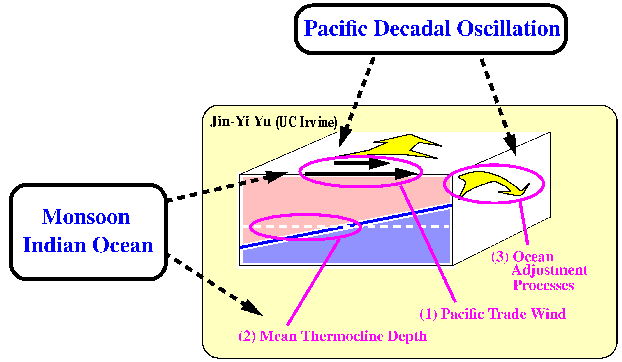
| [home] [Publications] [CP-ENSO] [New CGCM] [ENSO] [Monsoon] [Indian Dipole] [PDO] [TIW] [Tropics-Extratropics] [Cloud] [Jetstream] [Regional] [Gap Wind] |

Abstract
Pacific Decadal Oscillation (PDO) is characterized by climatic shifts
centered in the North Pacific. Some studies suggest this variability
results from the interactions between tropical and extratropical
Pacific Oceans. Other studies argue that the decadal variability can
be excited by the coupled atmosphere-ocean system over the
extratropical North Pacific, without interacting with the tropical
Pacific Ocean. It has also been suggested that PDO may contribute to
decadal changes in ENSO activity. At least two different modulation
mechanisms have been proposed. One emphasizes the existence of shallow
ocean pathway that allows PDO to influence ENSO activity through ocean
subduction. The other argues the decadal-scale variations in the
atmospheric general circulation over the Northern Pacific can extend
to the tropics. The slow changes in the trade wind system precondition
the mean state of the thermocline in the equatorial ocean, which leads
to prolonged periods of enhanced or reduced ENSO activity. We explore
those hypotheses of generation and modulation mechanisms by examining
the air-sea interactions associated with PDO in CGCM simulations.
Related Publications
[home]
[Publications]
[CP-ENSO]
[New CGCM]
[ENSO]
[Monsoon]
[Indian Dipole]
[PDO]
[TIW]
[Tropics-Extratropics]
[Cloud]
[Jetstream]
[Regional]
[Gap Wind]